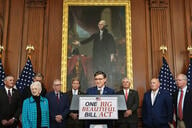You have /5 articles left.
Sign up for a free account or log in.

Visual Generation/Getty Images
Two recent reports are highlighting the need for reforms to income-driven plans for paying back student loans, as the repayment pause ends early next year and the Department of Education looks to create a new plan through the regulatory process.
Of the borrowers in repayment in the Education Trust’s study on how Black borrowers experience student loans, 72 percent were enrolled in an income-driven repayment, or IDR, plan. Those borrowers described IDR as something that feels like a “lifetime debt sentence,” said the report, which was based on a national survey of nearly 1,300 Black borrowers and in-depth interviews with 100 Black borrowers.
“Borrowers often felt like they were making payments without any end in sight, and that was compounded by other financial debt -- from payday loans or housing debt or car debt or credit card debt,” said Jalil Bishop, who co-authored the report. “They feel like education was supposed to give them the resources and opportunity to get ahead of those debts, but student loans have become a place where that debt is intensified.”
The Department of Education offers four IDR plans for repaying federal student loans that are supposed to make borrowers’ monthly payments more affordable by basing them on their income and family size. Each plan has a different repayment period, but they generally last between 20 and 25 years. Borrowers also have to recertify their income and family size every year so that their loan servicer can recalculate their payment. At the end of the repayment period, any remaining loan balance is forgiven.
In theory, IDR is supposed to help borrowers live a more comfortable life while they are repaying their debt. But that’s not what’s happening in reality, especially for Black borrowers, said Victoria Jackson, assistant director for higher education policy at the Education Trust. For some borrowers, the payments are still unaffordable -- nearly a quarter of those surveyed said they struggle paying for rent, health care and food, and 71 percent said they can’t afford a savings account.
Borrowers reported that the payments for IDR plans were so low that they only covered enough to keep them out of default but not enough to pay down the interest or principal of their loan. They often see their balance “ballooning,” said Jackson.
Most of the respondents -- 80 percent -- said they supported broad debt cancellation by the federal government, which Bishop said would help deal with “the history and pattern of mismanagement and bad design of the student loan repayment plans.” But borrowers also want reforms to IDR plans that would allow them to see real progress toward paying off their loans -- by subsidizing or eliminating interest -- and plans that align with the original terms of their student loans.
“When people borrow student loans, the standard repayment plan is 10 years,” Bishop said. “Many borrowers couldn't understand why they were on these 20- and 25-year plans, because when they borrowed the debt, they believed it was something they’d be able to repay not too long after graduating.”
The department has acknowledged many of these problems with IDR plans during the negotiated rule-making process, telling negotiators that it would like to create a new IDR plan that addresses the long repayment periods, accumulating interest, unaffordable payments and number of plans with differing terms. The challenges of having a variety of IDR plans were highlighted during the first negotiating session by Rachelle Feldman, associate provost and director at the University of North Carolina at Chapel Hill, who is serving as the alternate negotiator representing four-year public institutions.
“I just want to make a real plea to have fewer pathways so that it will be less confusing for everyone -- not just our [Public Service Loan Forgiveness] borrowers but our borrowers at every level,” Feldman said.
Daniel Kreisman, an associate professor of economics at Georgia State University, agrees, saying in a recent report for Third Way that the department should cut down on the options available for student loan repayment plans -- not just within IDR, but for repayment plans in general.
Borrowers are automatically enrolled into standard “fixed” repayment plans, which lead to the highest rates of loan defaults, wrote Kreisman. IDR plans could offer a better fit for borrowers, but there are hurdles to accessing them -- having to contact their loan servicer and continuously certify their income -- and many borrowers don’t know the option exists.
Kreisman ran a lab experiment at Georgia State with 542 undergraduate students where the preselected repayment plans were switched between groups. When the standard repayment plan was the default, 63 percent of students chose it. But when the IDR plan was the default, only 34 percent chose to enroll in a standard repayment plan.
“The simple takeaway is that changing the default option can be a low-cost, high-reward lever for the government -- and for students,” Kreisman wrote. “Right now, the burden is on borrowers to navigate an overly complex repayment system. All evidence points to this as a policy failure that is costing both students and taxpayers.”
Kreisman told Inside Higher Ed that he believes having an IDR plan as the only plan -- while still giving borrowers the option to prepay -- would help solve many of the problems that exist with IDR plans, such as having to recertify earnings each year. Negotiators also expressed concerns about the recertification process during the first negotiated rule-making session, but they turned to more automation and data sharing between federal agencies as a potential solution.
IDR plans could help keep many borrowers from defaulting when the repayment pause lifts on Jan. 31, 2022, said Kreisman. But the department won’t be able to fix the problems with the plans by then -- they don’t yet have proposed regulatory text on IDR plans for negotiators to consider. Still, given all that’s happening within federal student aid, the findings in the reports are necessary for those thinking about reforms.
“I think now is a good time to understand Black borrowers’ experience and what they want policy makers to do,” Jackson said.




